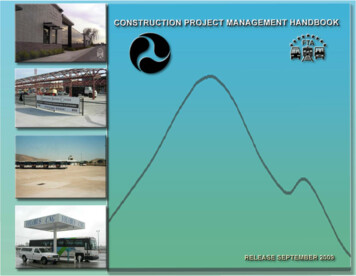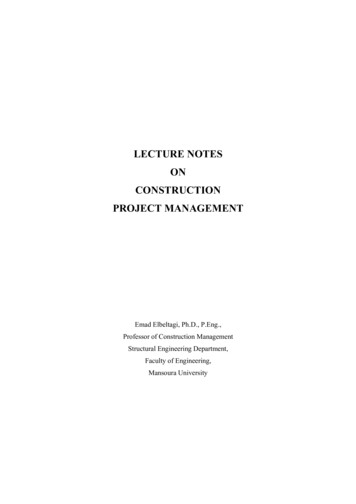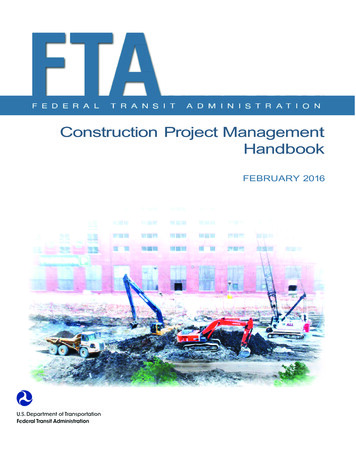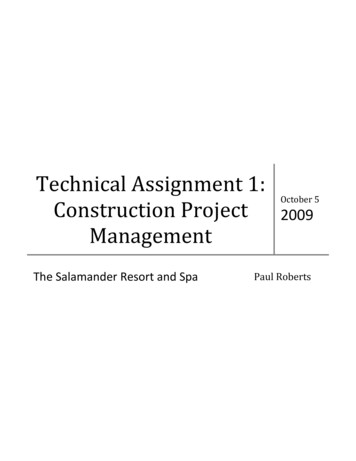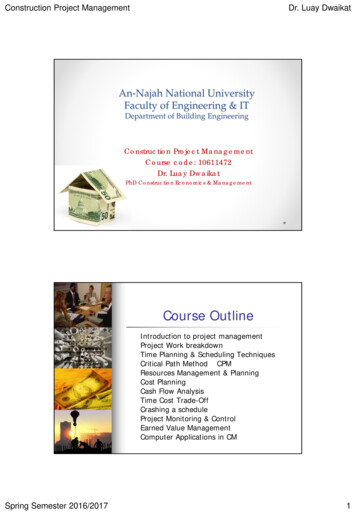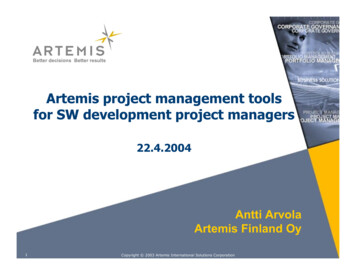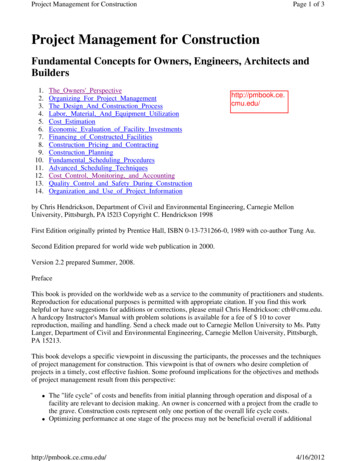
Transcription
Project Management for ConstructionPage 1 of 3Project Management for ConstructionFundamental Concepts for Owners, Engineers, Architects andBuilders1.2.3.4.5.6.7.8.9.10.11.12.13.14.The Owners' PerspectiveOrganizing For Project ManagementThe Design And Construction ProcessLabor, Material, And Equipment UtilizationCost EstimationEconomic Evaluation of Facility InvestmentsFinancing of Constructed FacilitiesConstruction Pricing and ContractingConstruction PlanningFundamental Scheduling ProceduresAdvanced Scheduling TechniquesCost Control, Monitoring, and AccountingQuality Control and Safety During ConstructionOrganization and Use of Project Informationhttp://pmbook.ce.cmu.edu/by Chris Hendrickson, Department of Civil and Environmental Engineering, Carnegie MellonUniversity, Pittsburgh, PA l52l3 Copyright C. Hendrickson 1998First Edition originally printed by Prentice Hall, ISBN 0-13-731266-0, 1989 with co-author Tung Au.Second Edition prepared for world wide web publication in 2000.Version 2.2 prepared Summer, 2008.PrefaceThis book is provided on the worldwide web as a service to the community of practitioners and students.Reproduction for educational purposes is permitted with appropriate citation. If you find this workhelpful or have suggestions for additions or corrections, please email Chris Hendrickson: cth@cmu.edu.A hardcopy Instructor's Manual with problem solutions is available for a fee of 10 to coverreproduction, mailing and handling. Send a check made out to Carnegie Mellon University to Ms. PattyLanger, Department of Civil and Environmental Engineering, Carnegie Mellon University, Pittsburgh,PA 15213.This book develops a specific viewpoint in discussing the participants, the processes and the techniquesof project management for construction. This viewpoint is that of owners who desire completion ofprojects in a timely, cost effective fashion. Some profound implications for the objectives and methodsof project management result from this perspective:zzThe "life cycle" of costs and benefits from initial planning through operation and disposal of afacility are relevant to decision making. An owner is concerned with a project from the cradle tothe grave. Construction costs represent only one portion of the overall life cycle costs.Optimizing performance at one stage of the process may not be beneficial overall if additionalhttp://pmbook.ce.cmu.edu/4/16/2012
Project Management for ConstructionzzzPage 2 of 3costs or delays occur elsewhere. For example, saving money on the design process will be a falseeconomy if the result is excess construction costs.Fragmentation of project management among different specialists may be necessary, but goodcommunication and coordination among the participants is essential to accomplish the overallgoals of the project. New information technologies can be instrumental in this process, especiallythe Internet and specialized Extranets.Productivity improvements are always of importance and value. As a result, introducing newmaterials and automated construction processes is always desirable as long as they are lessexpensive and are consistent with desired performance.Quality of work and performance are critically important to the success of a project since it is theowner who will have to live with the results.In essence, adopting the viewpoint of the owner focuses attention on the cost effectiveness of facilityconstruction rather than competitive provision of services by the various participants.While this book is devoted to a particular viewpoint with respect to project management forconstruction, it is not solely intended for owners and their direct representatives. By understanding theentire process, all participants can respond more effectively to the owner's needs in their own work, inmarketing their services, and in communicating with other participants. In addition, the specifictechniques and tools discussed in this book (such as economic evaluation, scheduling, managementinformation systems, etc.) can be readily applied to any portion of the process.As a result of the focus on the effective management of entire projects, a number of novel organizationalapproaches and techniques become of interest. First and foremost is the incentive to replaceconfrontation and adversarial relationships with a spirit of joint endeavor, partnership andaccomplishment. For example, we discuss the appropriate means to evaluate risks and the appropriateparticipants to assume the unavoidable risks associated with constructed facilities. Scheduling,communication of data, and quality assurance have particular significance from the viewpoint of anowner, but not necessarily for individual participants. The use of computer-based technology andautomation also provides opportunities for increased productivity in the process. Presenting suchmodern management options in a unified fashion is a major objective of this book.The unified viewpoint of the entire process of project management in this book differs from nearly allother literature on the subject. Most textbooks in the area treat special problems, such as cost estimating,from the viewpoint of particular participants such as construction managers or contractors. Thisliterature reflects the fragmentation of the construction process among different organizations andprofessionals. Even within a single profession such as civil engineering, there are quite distinct groupsof specialists in planning, design, management, construction and other sub-specialties. Fragmentation ofinterest and attention also exists in nearly all educational programs. While specialty knowledge may beessential to accomplish particular tasks, participants in the process should also understand the contextand role of their special tasks.This book is intended primarily as a text for advanced undergraduates, beginning graduate students orprofessionals continuing their education in engineering, construction, architecture or facilitiesmanagement. Examples and discussion are chosen to remind readers that project management is achallenging, dynamic and exciting enterprise and not just a record of past practices. It should also beuseful to professionals who wish an up-to-date reference on project management.Chapters 1 to 3 present an overview of the construction management and design process which shouldbe of interest to anyone engaged in project management for construction. One need not have detailedknowledge about individual tasks or techniques for this part. Individuals can read these chapters andhttp://pmbook.ce.cmu.edu/4/16/2012
Project Management for ConstructionPage 3 of 3understand the basic philosophy and principles without further elaboration.Chapters 4 through 14 describe specific functions and techniques useful in the process of projectmanagement. This part presents techniques and requirements during project planning, including riskassessment, cost estimation, forecasting and economic evaluation. It is during this planning and designphase in which major cost savings may be obtained during the eventual construction and operationphases. It also addresses programming and financing issues, such as contracting and bidding forservices, financing, organizing communication and insuring effective use of information. It furtherdiscusses techniques for control of time, cost and quality during the construction phase. Beginningcourses in engineering economics (including cash flow analysis and discounting), use of computers,probability and statistics would be useful. Furthermore, access to a personal computer with spreadsheetor equation solving software would be helpful for readers attempting some of the problems in Chapters 4to 14. Numerous software programs could be used for this purpose, including both spreadsheet andequation solving programs. Problems in some chapters could also be done on any number of existingsoftware packages for information management and project scheduling. However, the use of personalcomputers in this fashion is not required in following the text material. Each instructor may exercisediscretion in omitting some of the material in these chapters if they are redundant with other classes ortoo advanced for students in his or her own class.It is our hope that students beginning their career in project management for construction will beprepared to adopt the integrated approach emphasized in this book. Furthermore, experiencedprofessionals in various fields may discover in this book some surprises that even they have notanticipated. High level decision makers in owner organizations who are not directly involved in theproject management process may find the basic philosophy and principles of interest, especially inChapters 1 through 3, as owners must invariably pay for constructed facilities, for better or worse. If thebook can fulfill even a small part of its promises to influence the future of project management forconstruction, our efforts will have been amply rewarded.For version 2.1 (Summer 2003), a number of new examples, updates and references have been insertedthroughout the text. For example, there are new discussions of lean construction and green buildings.However, the basic structure and methods remain the same. The fundamentals of project managementtreated here are timeless.Numerous individuals helped with the preparation of the first and second editions of this book. Inparticular, we wish to acknowledge Burcu Akinci, William J. Hall, Paul Christiano, Steven Fenves,Daniel Rehak, Debbie Scappatura, and Shirley Knapp. Iavor Kostov, Tommy Hendrickson, Curt Yeskeand In-Soo Jung were instrumental in developing the web version of this book. This book also reflectsthe contributions of numerous students and colleagues in industry who have challenged us withproblems and shared their own ideas and experience over many years. We are grateful to all of theseindividuals.Some material in this book has been taken from several papers authored by us and published by theAmerican Society of Civil Engineers. Materials taken from other sources are acknowledged in footnotes,tables or figures. We gratefully acknowledge the permissions given to us by these individuals, publishersand organizations.A series of photographs depicting various stages of construction of the PPG building in Pittsburgh, PA isinserted in sequence between chapters. We wish to thank PPG Industries for its cooperation in providingthese photographs.Chris Hendrickson and Tung Auhttp://pmbook.ce.cmu.edu/4/16/2012
Project Management for Construction: The Owners' PerspectivePage 1 of 21Go Up to Table of ContentsGo To Chapter 2(Organizing for ProjectManagement)The Owners' PerspectiveIntroductionThe Project Life CycleMajor Types of ConstructionSelection of Professional ServicesConstruction ContractorsFinancing of Constructed FacilitiesLegal and Regulatory RequirementsThe Changing Environment of theConstruction IndustryThe Role of Project u/01 The Owners' Perspective.html1. The Owners' Perspective1.1 IntroductionLike the five blind men encountering different parts of an elephant, each of the numerous participants inthe process of planning, designing, financing, constructing and operating physical facilities has adifferent perspective on project management for construction. Specialized knowledge can be verybeneficial, particularly in large and complicated projects, since experts in various specialties can providevaluable services. However, it is advantageous to understand how the different parts of the process fittogether. Waste, excessive cost and delays can result from poor coordination and communication amongspecialists. It is particularly in the interest of owners to insure that such problems do not occur. And itbehooves all participants in the process to heed the interests of owners because, in the end, it is theowners who provide the resources and call the shots.By adopting the viewpoint of the owners, we can focus our attention on the complete process of projectmanagement for constructed facilities rather than the historical roles of various specialists such asplanners, architects, engineering designers, constructors, fabricators, material suppliers, financialanalysts and others. To be sure, each specialty has made important advances in developing newtechniques and tools for efficient implementation of construction projects. However, it is through theunderstanding of the entire process of project management that these specialists can respond moreeffectively to the owner's desires for their services, in marketing their specialties, and in improving theproductivity and quality of their work.The introduction of innovative and more effective project management for construction is not anacademic exercise. As reported by the "Construction Industry Cost Effectiveness Project" of theBusiness Roundtable: [1]By common consensus and every available measure, the United States no longer gets it'smoney's worth in construction, the nation's largest industry . The creeping erosion ofconstruction efficiency and productivity is bad news for the entire U.S. economy.http://pmbook.ce.cmu.edu/01 The Owners' Perspective.html4/16/2012
Project Management for Construction: The Owners' PerspectivePage 2 of 21Construction is a particularly seminal industry. The price of every factory, office building,hotel or power plant that is built affects the price that must be charged for the goods orservices produced in it or by it. And that effect generally persists for decades . Too muchof the industry remains tethered to the past, partly by inertia and partly by historicdivisions.Improvement of project management not only can aid the construction industry, but may also be theengine for the national and world economy. However, if we are to make meaningful improvements, wemust first understand the construction industry, its operating environment and the institutionalconstraints affecting its activ
First Edition originally printed by Prentice Hall, ISBN 0-13-731266-0, 1989 with co-author Tung Au. Second Edition prepared for world wide web publication in 2000. Version 2.2 prepared Summer, 2008. Preface This book is provided on the worldwide web as a service to

